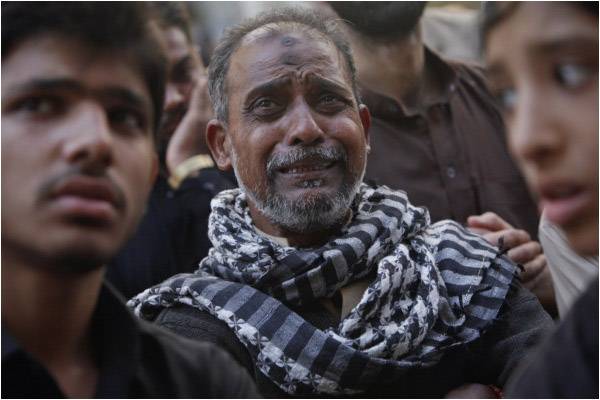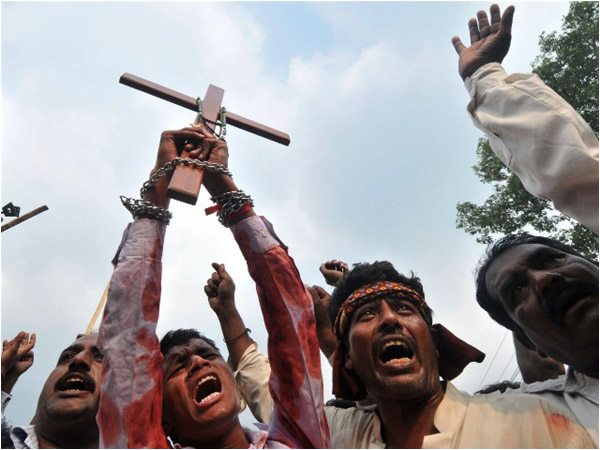
Last week, a 50 year old Muslim man was beaten to death, and his son severely injured, by an enraged mob in Dadri, a small town in the Indian state of Uttar Pradesh. Rumors of the family storing and consuming beef precipitated the event in the largely Hindu community. By all accounts, it is a tale of intolerable cruelty – a tragedy of inhuman proportions. Within a day, Twitter was all atwitter with the hash tag #PlightofIndianMuslims, with Pakistanis berating the Modi administration for allowing Muslim killings, and arguing how unsafe India is for Muslims.
The irony of this blowback is the #PlightofPakistaniMinorities in our own backyard, because we as a nation are so numb to violence against marginalized people, it barely registers on our sympathy radar. Data suggests that violence against civilians has decreased overall since 2014. Numbers from the first three quarters show a marked decrease in terrorist attacks and resulting fatalities. However, this trend has only reversed for minorities. In fact, since the enactment of the National Action Plan (NAP) in December 2014, precipitated by the atrocious attack on schoolchildren at the Army Public School (APS) in Peshawar Cantonment, minorities have primarily faced the brunt of the extremist threat.
The statistics speak for themselves. In the first quarter for 2015, 384 casualties resulted from violence against minorities, and the communities that suffered the most were Shias (230), Christians (86), and Hindus (15). This was a 38% increase over the same quarter from the prior year, while the overall security situation had improved with a nearly 20% dip in fatalities compared with the first quarter of 2014.
Despite a few high-profile attacks, the second quarter of the year showed a steady decline in violence overall, and against minorities. The fatalities were much lower compared with both the previous quarter and the same period in 2014. However, this “improvement” included the barbaric attack on the Ismaili community’s bus resulting in the deaths of 45 individuals in the month of May. Early indicators show a further decline in violence against minorities in the third quarter, but there have already been reports of the deaths of two members of the Hindu community.
These are just casualties. Forced conversions, sexual assaults, state obliviousness, and daily social persecution are additional problems that minorities in Pakistan face every day. India Today reported in August 2015 that the Indian Hindu population is decreasing, while the Muslim population continues to show growth, reaching 172.2 million between 2001 and 2011. In Pakistan, where Hindus represent a mere 1.6% to 1.85% of the population at around 2.5 million (estimated in 2005), the National Assembly was told in May 2014 that nearly 5,000 Hindus flee the country annually to avoid oppression. A report from the Movement for Solidarity and Peace estimates that nearly 1,000 non-Muslim girls are forcibly converted to Islam in Pakistan every year, and that number, in relation to the population percentages, is heavily skewed towards Hindus. The state apparatus is often too slow to react, if it reacts at all. Families face significant hurdles just registering a First Information Report (FIR) with the police. Even if every state organ cooperates in registering a complaint, in the case of forced conversions, there has been no court ruling in support of the prosecuting Hindu family to date.

“Associated with the insistence on the ‘Ideology of Pakistan’ has been an essential component of hate against India and the Hindus. For the upholders of the ‘Ideology of Pakistan’, the existence of Pakistan is defined only in relation to Hindus, and hence the Hindus have to be painted as negatively as possible,” says a Sustainable Development Policy Institute report from 2011. Our collective national obsession with bemoaning India’s treatment of its Muslim population is ironic not only because of Pakistan’s maltreatment of Hindus and other minorities, but because Hindu-bashing is a core element of the hardline version of the ideology of Pakistan.
#PlightofIndianMuslims is a real concern, and their mistreatment is deplorable. But before we toss that brick through the neighbor’s window, we should get our own house in order, and accept that we are collectively guilty of the same crime. For a twenty-four hour period last week, #PlightofIndianMuslims was the top trend on social media. Perhaps it is time we shift this narrative focus to the #PlightofPakistaniMinorities.
The #PlightofIndianMuslims dogmatists, quick to thank Jinnah for creating a safe haven for Muslims, paradoxically refuse to acknowledge his words to the First Constituent Assembly:
“You are free; you are free to go to your temples, you are free to go to your mosques or to any other places of worship in the State of Pakistan. You may belong to any religion or caste or creed – that has nothing to do with the business of the State … We are starting with this fundamental principle: that we are all citizens and equal citizens of one State. Now, I think we should keep that in front of us as our ideal and you will find that in course of time Hindus would cease to be Hindus and Muslims would cease to be Muslims, not so in the religious sense because that is the personal faith of each individual, but in the political sense as citizens of the state.”
The author is a journalist and a Senior Research Fellow at the Center for Research and Security Studies, Islamabad. He has a Master’s degree in strategic communications from Ithaca College, NY.
Email: zeeshan[dot]salahuddin[at]gmail.com
Twitter: @zeesalahuddin
The irony of this blowback is the #PlightofPakistaniMinorities in our own backyard, because we as a nation are so numb to violence against marginalized people, it barely registers on our sympathy radar. Data suggests that violence against civilians has decreased overall since 2014. Numbers from the first three quarters show a marked decrease in terrorist attacks and resulting fatalities. However, this trend has only reversed for minorities. In fact, since the enactment of the National Action Plan (NAP) in December 2014, precipitated by the atrocious attack on schoolchildren at the Army Public School (APS) in Peshawar Cantonment, minorities have primarily faced the brunt of the extremist threat.
Nearly 5,000 Hindus flee the country annually to avoid oppression
The statistics speak for themselves. In the first quarter for 2015, 384 casualties resulted from violence against minorities, and the communities that suffered the most were Shias (230), Christians (86), and Hindus (15). This was a 38% increase over the same quarter from the prior year, while the overall security situation had improved with a nearly 20% dip in fatalities compared with the first quarter of 2014.
Despite a few high-profile attacks, the second quarter of the year showed a steady decline in violence overall, and against minorities. The fatalities were much lower compared with both the previous quarter and the same period in 2014. However, this “improvement” included the barbaric attack on the Ismaili community’s bus resulting in the deaths of 45 individuals in the month of May. Early indicators show a further decline in violence against minorities in the third quarter, but there have already been reports of the deaths of two members of the Hindu community.
These are just casualties. Forced conversions, sexual assaults, state obliviousness, and daily social persecution are additional problems that minorities in Pakistan face every day. India Today reported in August 2015 that the Indian Hindu population is decreasing, while the Muslim population continues to show growth, reaching 172.2 million between 2001 and 2011. In Pakistan, where Hindus represent a mere 1.6% to 1.85% of the population at around 2.5 million (estimated in 2005), the National Assembly was told in May 2014 that nearly 5,000 Hindus flee the country annually to avoid oppression. A report from the Movement for Solidarity and Peace estimates that nearly 1,000 non-Muslim girls are forcibly converted to Islam in Pakistan every year, and that number, in relation to the population percentages, is heavily skewed towards Hindus. The state apparatus is often too slow to react, if it reacts at all. Families face significant hurdles just registering a First Information Report (FIR) with the police. Even if every state organ cooperates in registering a complaint, in the case of forced conversions, there has been no court ruling in support of the prosecuting Hindu family to date.

“Associated with the insistence on the ‘Ideology of Pakistan’ has been an essential component of hate against India and the Hindus. For the upholders of the ‘Ideology of Pakistan’, the existence of Pakistan is defined only in relation to Hindus, and hence the Hindus have to be painted as negatively as possible,” says a Sustainable Development Policy Institute report from 2011. Our collective national obsession with bemoaning India’s treatment of its Muslim population is ironic not only because of Pakistan’s maltreatment of Hindus and other minorities, but because Hindu-bashing is a core element of the hardline version of the ideology of Pakistan.
#PlightofIndianMuslims is a real concern, and their mistreatment is deplorable. But before we toss that brick through the neighbor’s window, we should get our own house in order, and accept that we are collectively guilty of the same crime. For a twenty-four hour period last week, #PlightofIndianMuslims was the top trend on social media. Perhaps it is time we shift this narrative focus to the #PlightofPakistaniMinorities.
The #PlightofIndianMuslims dogmatists, quick to thank Jinnah for creating a safe haven for Muslims, paradoxically refuse to acknowledge his words to the First Constituent Assembly:
“You are free; you are free to go to your temples, you are free to go to your mosques or to any other places of worship in the State of Pakistan. You may belong to any religion or caste or creed – that has nothing to do with the business of the State … We are starting with this fundamental principle: that we are all citizens and equal citizens of one State. Now, I think we should keep that in front of us as our ideal and you will find that in course of time Hindus would cease to be Hindus and Muslims would cease to be Muslims, not so in the religious sense because that is the personal faith of each individual, but in the political sense as citizens of the state.”
The author is a journalist and a Senior Research Fellow at the Center for Research and Security Studies, Islamabad. He has a Master’s degree in strategic communications from Ithaca College, NY.
Email: zeeshan[dot]salahuddin[at]gmail.com
Twitter: @zeesalahuddin

